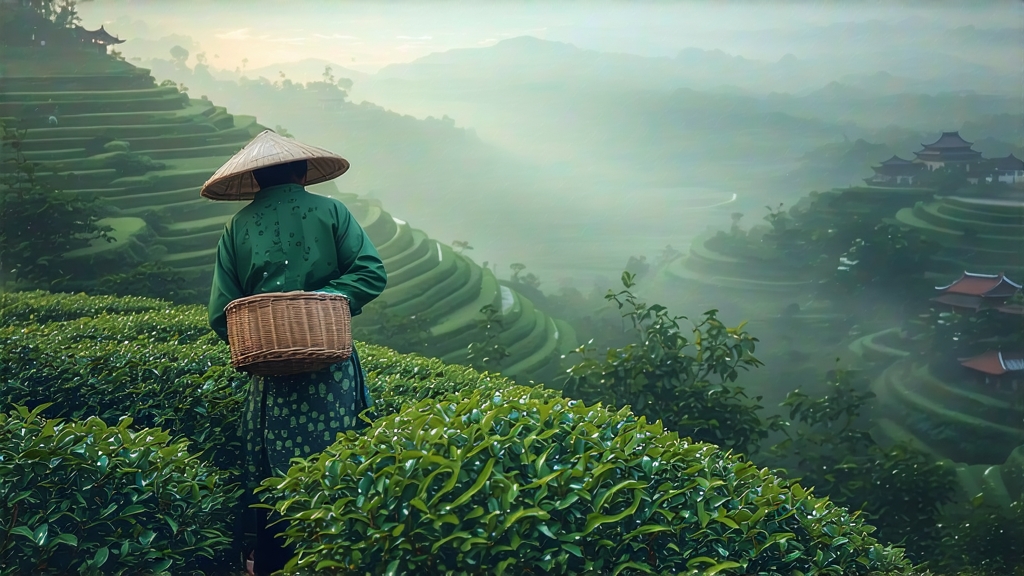
Among the pantheon of Chinese green teas, few names evoke as much poetic reverence as Biluochun. Literally “Green Snail Spring,” the tea is celebrated for its tiny spiral-shaped leaves, intoxicating fruit-and-flower aroma, and a sweetness so pure it once compelled a Qing-dynasty emperor to rechristen the tea with its current elegant title. To international drinkers accustomed to the vegetal briskness of Japanese sencha or the nutty depth of Longjing, Biluochun offers a sensory detour into a realm where tea tastes like spring itself—delicate, lacy, and almost effervescent on the tongue.
Historical roots
Biluochun’s origin story is anchored in the mist-laden hills of Dongting Mountain, an island range rising from Lake Tai in Jiangsu Province. According to local chronicles compiled during the late Ming, tea monks noticed an unusually fragrant wild tea growing among peach, plum, and loquat trees. When infused, the liquor exuded an aroma reminiscent of the surrounding orchard blossoms, prompting the name “Xia Sha Ren Xiang”—literally “scary-rich fragrance.” In 1699 the Kangxi Emperor sampled the tea while touring the region; enchanted, he declared the original name too vulgar and bestowed the refined moniker Biluochun, referencing the snail-shell curl of the finished leaf and the spring harvest season. Imperial patronage catapulted the tea into national fame, and by the mid-Qing it ranked first among Chinese greens in palace tribute lists.
Micro-terroirs and cultivars
Dongting Mountain is actually two contiguous islands—Dongshan (East Mountain) and Xishan (West Mountain)—each circled by lake water that moderates temperature and refracts sunlight into a soft, diffused glow. The constant humidity nurtures a slow, tender leaf growth rich in amino acids, especially L-theanine, which translates into the tea’s signature umami sweetness. Growers traditionally interplant tea bushes with fruit trees; fallen petals and ripening fruit contribute volatile esters that the tea leaf absorbs like a living blotter. While the classic landrace cultivar is the small-leaf “Dongting Qunti,” clonal selections such as Fuding Dabaicha and Wuniuzao are now cultivated at lower elevations to extend the harvest window. Purists, however, insist that only the original Qunti bushes growing above the 200 m contour line, where morning mist lingers until ten o’clock, yield the true “mountain essence” flavor.
Harvest calendar
Biluochun is one of China’s earliest spring greens. Plucking begins around the Qingming festival (early April) when two leaves and a bud measure barely 2 cm in length. The most coveted grade, Mingqian (pre-Qingming), is picked when the overnight temperature hovers just above 5 °C; the cold stress concentrates fragrant compounds. A skilled picker can harvest only 600 g of fresh leaf in a day—roughly 30 000 tiny shoots—which will shrink to 150 g after firing. Such scarcity explains why top-lot Biluochun can command over US $1 000 per 500 g at auction.
Crafting the spiral
The transformation from fragile sprout to jade curl is a ballet of heat, pressure, and timing performed within twelve hours of plucking. First, the leaves are spread in bamboo trays and withered for 60–90 minutes to reduce moisture to 68–70 %. Next comes the kill-green stage, unique among Chinese greens for its unusually low pan temperature—only 80 °C. The tea master uses a feather-light touch, repeatedly tossing the leaf to prevent scorching while locking in the bright green hue. The critical shaping step follows: handfuls of hot leaf are rolled against the sloping wall of a cast-iron wok curved like a shallow bell. Using three fingers the master applies a spiraling pressure, coaxing the leaf to curl into the signature snail shell. The motion must be clockwise and rhythmic; one extra second and the leaf cracks, releasing bitter catechins. Finally, the tea is dried in three short bursts at 60 °C, 50 °C, and 40 °C, each followed by a five-minute rest to allow internal moisture to migrate outward. The entire process consumes four hours, after which the leaf moisture drops to 5 % and the aroma peaks with a perfume compared by poets to “spring orchards after light